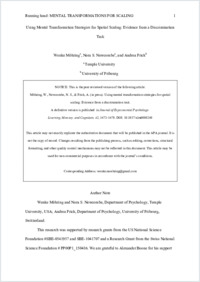Using mental transformation strategies for spatial scaling: Evidence from a discrimination task
- Möhring, Wenke Temple University
- Newcombe, Nora S. Temple University
- Frick, Andrea University of Fribourg
-
2016
Published in:
- Journal of Experimental Psychology: Learning, Memory, and Cognition. - APA. - 2016, vol. 42, no. 9, p. 1473-1479
English
Spatial scaling, or an understanding of how distances in different-sized spaces relate to each other, is fundamental for many spatial tasks and relevant for success in numerous professions. Previous research has suggested that adults use mental transformation strategies to mentally scale spatial input, as indicated by linear increases in response times and accuracies with larger scaling magnitudes. However, prior research has not accounted for possible difficulties in encoding spatial information within smaller spaces. Thus, the present study used a discrimination task in which we systematically pitted absolute size of the spaces against scaling magnitude. Adults (N = 48) were presented with 2 pictures, side-by-side on a computer display, each of which contained a target. Adults were asked to decide whether the targets were in the same position or not, by pressing the respective computer key. In the constant-large condition, the constant space was kept large, whereas the size of the other space was variable and smaller. In the constant-small condition, the constant space was small, whereas the size of the other space was variable and larger. Irrespective of condition, adults’ discrimination performance (d- primes) and response times were linear functions of scaling magnitude, supporting the notion that analog imagery strategies are used in spatial scaling.
- Faculty
- Faculté des lettres et des sciences humaines
- Department
- Département de Psychologie
- Language
-
- English
- Classification
- Psychology
- License
-
License undefined
- Identifiers
-
- RERO DOC 304970
- DOI 10.1037/xlm0000240
- Persistent URL
- https://folia.unifr.ch/unifr/documents/305885
Statistics
Document views: 127
File downloads:
- Texte intégral: 172
